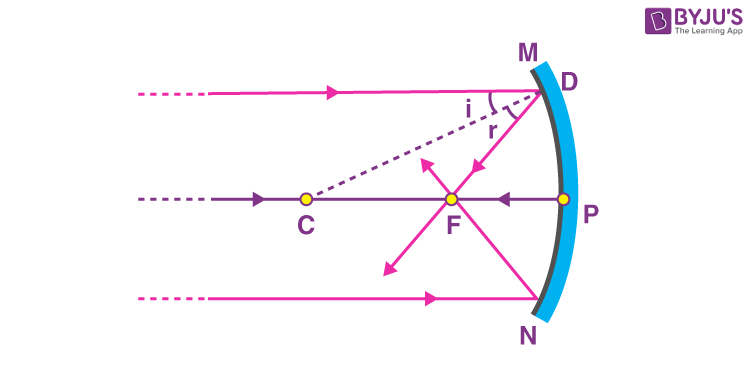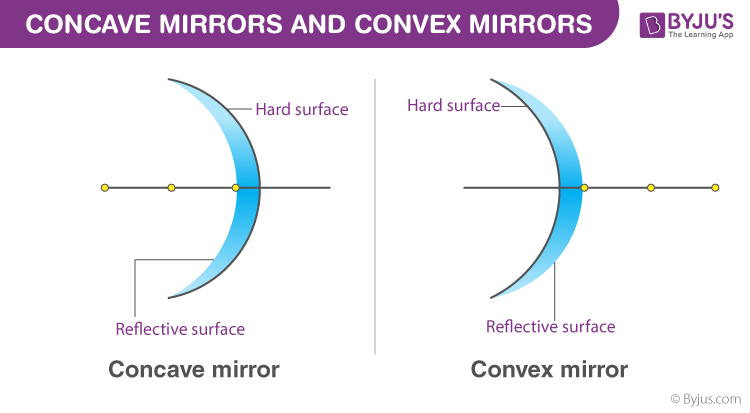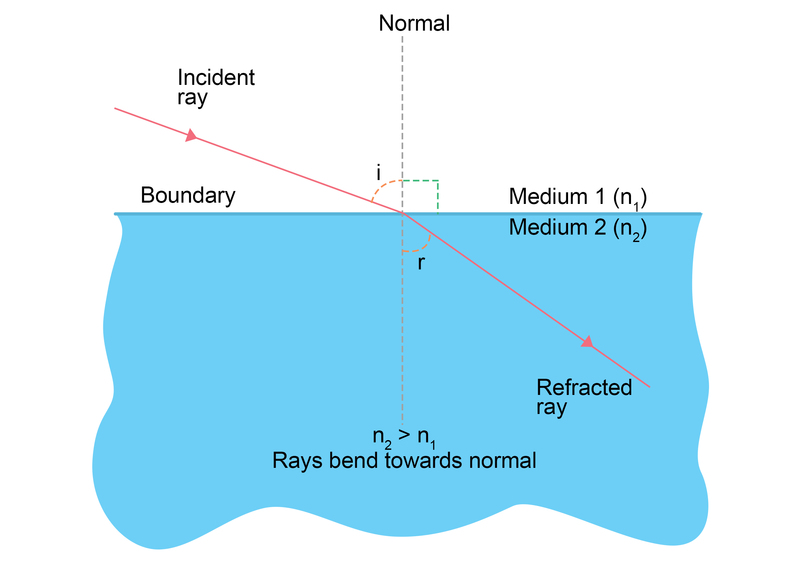Light- Reflection and Refraction
0.0(0)
0.0(0)
Card Sorting
1/27
Earn XP
Description and Tags
Study Analytics
Name | Mastery | Learn | Test | Matching | Spaced |
|---|
No study sessions yet.
28 Terms
1
New cards
Mirror formula
1/v + 1/u = 1/f
2
New cards
Magnification formula
-V/u and h1/h
3
New cards
Focal length formula
R/2
4
New cards
Laws of Reflection
The incident ray, reflected ray and the normal all lie in the same plane. Angle of incidence = Angle of reflection
[∠i=∠r]
[∠i=∠r]
5
New cards
Light incident on surface separating two media
When light travels from one medium to another medium it either:
gets absorbed (absorption)
bounces back (reflection)
passes through or bends (refraction)
When light is incident on a plane mirror, most of it gets reflected, and some of it gets absorbed in the medium.
gets absorbed (absorption)
bounces back (reflection)
passes through or bends (refraction)
When light is incident on a plane mirror, most of it gets reflected, and some of it gets absorbed in the medium.
6
New cards
Image formation by a plane mirror
The image formed by a plane mirror is always virtual and erect.
Object and image are equidistant from the mirror.
Object and image are equidistant from the mirror.
7
New cards
Characteristics of images
Images can be real or virtual, erect or inverted, magnified or diminished. A real image is formed by the actual convergence of light rays. A virtual image is the apparent convergence of diverging light rays.
If an image formed is upside down then it is called inverted or else it is an erect image. If the image formed is bigger than the object, then it is called magnified. If the image formed is smaller than the object, then it is diminished.
If an image formed is upside down then it is called inverted or else it is an erect image. If the image formed is bigger than the object, then it is called magnified. If the image formed is smaller than the object, then it is diminished.
8
New cards
Relationship between focus and radius of curvature
Focal length is half the distance between pole and radius of curvature.

9
New cards
Two types of spherical mirrors
Concave mirror and
Convex mirror
Convex mirror

10
New cards
Pole (P)
The midpoint of a spherical mirror.
11
New cards
The radius of curvature (r)
The distance between the centre of curvature and the spherical mirror. This radius will intersect the mirror at the pole (P).
12
New cards
Centre of curvature (C)
The centre of the sphere that the spherical mirror was a part of.
13
New cards
Principal Axis
The line passing through the pole and the centre of curvature is the main or principal axis.
14
New cards
Concave Mirror
A spherical mirror with the reflecting surface that bulges inwards.
15
New cards
Convex mirror
A spherical mirror with the reflecting surface that bulges outwards.
16
New cards
Focus (F)
Take a concave mirror. All rays parallel to the principal axis converge at a point between the pole and the centre of curvature. This point is called as the focal point or focus.
17
New cards
Focal length
Distance between pole and focus
18
New cards
Rules of ray diagram for representation of images formed
A ray passing through the centre of curvature hits the concave spherical mirror and retraces its path.
Rays parallel to the principal axis passes through the focal point or focus.
Rays parallel to the principal axis passes through the focal point or focus.
19
New cards
Image formation by spherical mirrors

20
New cards
Position and Size of image formed
Size of image can be found using the magnification formula
m = h’/h = – (v/u)
(If m is -ve it is a real image and if it is +ve it is a virtual image.)
m = h’/h = – (v/u)
(If m is -ve it is a real image and if it is +ve it is a virtual image.)
21
New cards
Refraction
The shortest path need not be the quickest path. Since light is always in a hurry, it bends when it enters a different medium as it is still following the quickest path. This phenomenon of light bending in a different medium is called refraction.

22
New cards
Laws of refraction
The incident ray, the refracted ray and the normal to the interface of two transparent media at the point of incidence, all lie in the same plane.
The ratio of the sine of the angle of incidence to the sine of the angle of refraction is a constant, for the light of a given colour and for the given pair of media. This law is also known as Snell’s law of refraction.
The ratio of the sine of the angle of incidence to the sine of the angle of refraction is a constant, for the light of a given colour and for the given pair of media. This law is also known as Snell’s law of refraction.
23
New cards
Refraction through a rectangular glass slab
When the light is incident on a rectangular glass slab, it emerges out parallel to the incident ray and is laterally displaced. It moves from rarer to denser medium and then again to the rarer medium.
24
New cards
Refractive index formula
n = sin∠i/sin∠r
= speed of light in medium 1/speed of light in medium2.
= speed of light in medium 1/speed of light in medium2.
25
New cards
Speed of light in vaccum
n = c/v
where n is the refractive index of a medium, c is the velocity of light in a vacuum and v is the velocity of light in that particular medium.
where n is the refractive index of a medium, c is the velocity of light in a vacuum and v is the velocity of light in that particular medium.
26
New cards
Uses of convex mirror
Used as rear view mirror.
-they always give an erect though diminished image.
-they have a wider field of view as they are curved outwards
Used in shops as security mirrors.
-they always give an erect though diminished image.
-they have a wider field of view as they are curved outwards
Used in shops as security mirrors.
27
New cards
Uses of concave mirror
Used in torches, headlights, search lights.
Used by dentists to see larger image of the teeth of the patient
Used to concentrate the sunlight and produce heat in solar furnaces
Used by dentists to see larger image of the teeth of the patient
Used to concentrate the sunlight and produce heat in solar furnaces
28
New cards
Characteristics of image formed by a plane mirror
Virtual and erect.
Image size = object size.
Image formed is far behind the mirror as the object is in front of it.
Inverted.
Image size = object size.
Image formed is far behind the mirror as the object is in front of it.
Inverted.